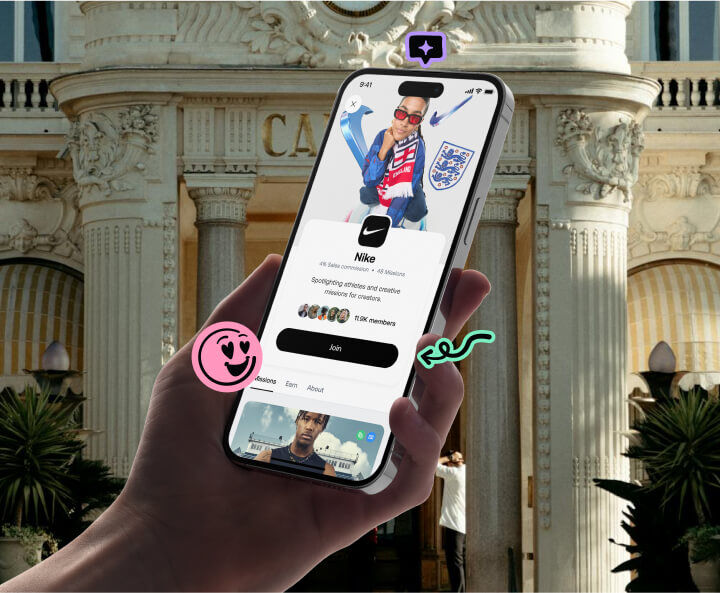What you need to know about influencer conversion rates
 What you need to know about influencer conversion rates">
What you need to know about influencer conversion rates">
- Introduction
- What exactly are influencer conversion rates?
- Why do influencer conversion rates matter?
- What are the key factors affecting influencer conversion rates?
- How do you track influencer conversion rates?
- How can influencer conversion rates be improved?
- Focus on the long game
- Mastering influencer conversion rates

Introduction
Brands that grasp how these rates work can make informed decisions about their influencer partnerships and allocate their marketing budget wisely. So, let’s dive into everything you need to know about influencer conversion rates and how to leverage them for the best results.

What exactly are influencer conversion rates?
Simply put, an influencer conversion rate is the percentage of followers who complete a desired action after interacting with an influencer’s content. For example, if 1,000 people view an influencer's post and 50 of them make a purchase, the influencer conversion rate is 5%.
Conversion rates are critical for brands because they highlight the effectiveness of an influencer’s content in moving followers from passive viewers to active customers. High conversion rates signify a strong return on investment (ROI), making them an essential metric for evaluating influencer collaborations.

Why do influencer conversion rates matter?
Why should you care about influencer conversion rates? It all comes down to efficiency and impact. Businesses aim to maximise their marketing budgets, and working with influencers who have higher conversion rates ensures a better ROI.
In a competitive market, it’s not just about reaching as many people as possible but converting them into loyal customers. Analysing these rates helps brands refine their marketing strategies and focus on influencers who drive actual results.

What are the key factors affecting influencer conversion rates?
Follower engagement
High follower engagement often correlates with higher conversion rates. Engagement includes likes, comments, shares and saves, indicating that followers are invested in the influencer’s content. An engaged audience is more likely to trust and act on the influencer’s recommendations.
Quality and relevance of content
The effectiveness of an influencer’s content is determined by its quality and relevance to their audience. If a promoted product fits seamlessly into the influencer’s usual content and resonates with their followers, it’s more likely to lead to conversions. Tailored and well-thought-out content is a game-changer.
Trust and credibility
The influencer’s relationship with their audience plays a crucial role in conversion rates. Followers are more inclined to take action if they perceive the influencer as genuine and trustworthy. This authenticity can make or break a campaign, especially in an age where audiences can spot an insincere promotion a mile away.
Audience targeting
Precision in targeting is key. Niche influencers often have a more dedicated and focused audience, which can result in higher conversion rates. Brands should collaborate with influencers whose followers align closely with their target demographic for the best outcomes.
Call-to-action (CTA)
A compelling and clear CTA is essential for driving conversions. If an influencer specifies what their followers should do next – like “click the link in my bio” or “swipe up to shop” – it increases the likelihood that followers will take the desired action. Experimenting with different CTAs can also help find the most effective approach.
Follower size
While a larger follower count might seem appealing, it doesn’t always translate to higher conversion rates. Micro and nano-influencers often have smaller but more loyal and engaged audiences, which can lead to better conversion metrics. Quality often trumps quantity when it comes to engagement and trust.

How do you track influencer conversion rates?
Understanding what influences conversion rates is one thing, but tracking them effectively is another. Here are some methods to measure the impact of influencer marketing:
Promotional discount codes
One of the simplest and most effective tracking methods is using unique discount codes. Each influencer receives a code specifying a discount that their followers can use at checkout. Every time the code is used, it’s recorded, providing a straightforward way to track conversions.
Affiliate links
Assigning influencers specific affiliate links is another common method. These links are trackable, showing exactly how many people clicked and made a purchase. This method not only measures conversion rates but can also be tied to commission-based compensation.
UTM parameters
UTM parameters are those extra bits of text added to URLs for tracking purposes. They help brands identify where website traffic comes from and which influencer campaigns are driving the most conversions. While setting up UTMs may seem technical, they’re easy to set up with Google’s Campaign URL Builder and provide invaluable insights into campaign performance.
Instagram features
For brands focused on social media, Instagram’s “Swipe Up” feature and Shopping tags are invaluable. These tools give brands direct data on how many followers engaged with an influencer’s content to visit a website or make a purchase. They are particularly useful for impulse shopping.
Customer surveys
While seemingly old-school, customer surveys can still provide valuable insights. Simply asking customers how they heard about your product can help determine the influence of a campaign. Although less precise than digital tracking, surveys offer additional context that numbers alone can’t capture.
How can influencer conversion rates be improved?
Build strong relationships with influencers
A genuine relationship goes a long way. Work closely with influencers to understand their values and motivations. The more authentic the partnership, the more likely it is to yield strong results. Open communication fosters trust and encourages influencers to produce content that resonates with their audience.
Guide content creation
While creators are experts in engaging their followers, providing creative direction can improve conversion outcomes. Encourage storytelling and ensure you create clear guidelines on how to showcase your product naturally within their daily life. This approach feels more authentic and relatable, increasing the likelihood of conversions.
Craft clear and compelling CTAs
A well-crafted CTA can make all the difference. Guide influencers on how to create effective CTAs that are clear and action-oriented. Whether it’s “Shop now,” “Join today” or “Learn more,” experimenting with different phrases can help identify what works best for each audience.
Encourage audience interaction
Influencers who engage with their followers – by responding to comments or sparking discussions – build a sense of community. This engagement can drive higher conversion rates, as followers feel more connected and invested in the influencer’s recommendations.
Rotate influencers for fresh content
Even successful influencers can become stale over time. Introducing new faces can reignite interest and reach new segments of your target audience. A rotating cast of influencers in your ambassador campaign keeps your content dynamic and intriguing.
Focus on niche influencers
Instead of partnering with influencers who have broad appeal, consider collaborating with niche creators whose followers closely match your ideal customer profile. Niche influencers often have a deeper understanding of their audience, leading to more effective and targeted campaigns.

Focus on the long game
Boosting influencer conversion rates isn’t an overnight task. It requires patience, constant tweaking and a willingness to learn from the data.
Track your progress, make adjustments as needed, and remember that every campaign offers a learning opportunity. The key is to stay persistent and keep optimising your strategies based on performance metrics.

Mastering influencer conversion rates
Influencer conversion rates are more than just a metric; they’re a window into the effectiveness of your marketing efforts. By understanding the factors that influence these rates and using the right tracking methods, you can fine-tune your campaigns and maximise ROI.
Building strong, authentic partnerships with influencers and continuously refining your approach will set your brand up for long-term success in the world of influencer marketing.
Ready to improve conversion rates? Learn more about Club’s solution for managing micro-influencer marketing campaigns!
Keep up with the
latest from Club

Get more inspiration

10 influencer marketing pros & cons social media managers should know


Top brand ambassador perks: 6 effective ways to reward and motivate sales champions


Understanding brand ambassador cost: what it really takes to run a successful program


 Book a demo
Book a demo

